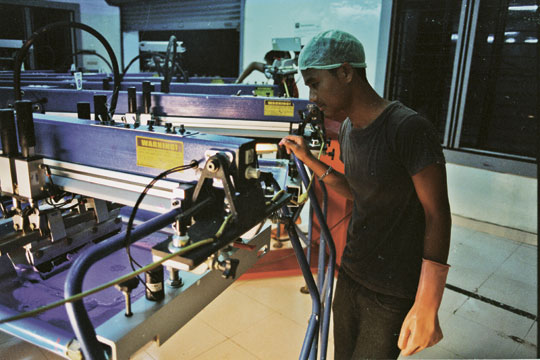Creative Textile Mill (Pvt) Ltd is a name that is synonyms with quality and perfection when it comes to fabric and apparel suppliers in Sri Lanka. Surpassing other apparel manufactures in Sri Lanka, Creative Textile Mill is committed to providing the very best when it comes to garments and finished fabrics in Sri Lanka and takes its fabric manufacturing very seriously. Cotton, being the premium fabric for garments in Sri Lanka, is manufactured in three carefully monitored steps- dyeing, printing and finishing and this process takes place at Cliftex after the weaving process is completed at Creative Textile Mills. Here’s a closer look at the three steps of cotton manufacturing:
Dyeing
Dyeing has two regular processes- yarn dyeing and piece dyeing, though computers are now used to formulate and match colors with greater speed and efficiency.
Yarn dyeing is normally applied before the cloth is knitted or woven and is popularly used on plaids, gingham checks, woven stripes, etc. One of the widely used yarn dyeing methods is package dyeing where the yarn is wound on perforated cylinders or packages and positioned on vertical spindles in a round dyeing machine. Then the dye solution is pressed alternately from the outside of the cylinders inward and from the inside under pressure.
Piece dyeing is principally used for fabrics that require a solid color. The process starts with a continuous length of dry cloth being passed through a trough of hot dye mixture. The fabric then gets pressed between padded rollers that compress the colour out evenly and remove the surplus dye solution. Another variation of the piece dyeing method is where the fabric is made into a tight rope-like coil and then processed on a reel that passes in and out of a dye vat.
Printing
The printing process is very similar to the process of printing on paper. For fabrics of the same design, a roller print machine is used and this machine operates at speeds between 50 to 100 yards a minute. As many as ten different colors can be printed in one single operation. The printed cloth is then dried instantly and transferred on to an oven that helps set the dye.
Automatic screen-printing is another primary method for printing designs. Though it’s slower than the roller printing process, screen- printing can produce much larger and elaborate designs and shadings.
Another method is the flat bed screen-printing where the fabric design is replicated in fine mesh screens. These flat bed machines have speeds of up to 1,200 yards per hour for a fabric with a 36-inch design repeat.
The recent rotary screen printing machines is, by far, the fastest with speeds of up to 3,500 yards an hour and as many as 16 colors can be printed on one length of fabric.
Finishing
This is the final step in the process of finished fabrics in Sri Lanka. Numerous finishes can be affected on fabrics and the techniques of applications can be different as the finishes. Cotton fabrics are finished in more different methods than other types of fabrics. For example, some finishes alter the look and feel of the cotton fabric and other finishes can add different characteristics like shrinkage control and durable press.


No Comments